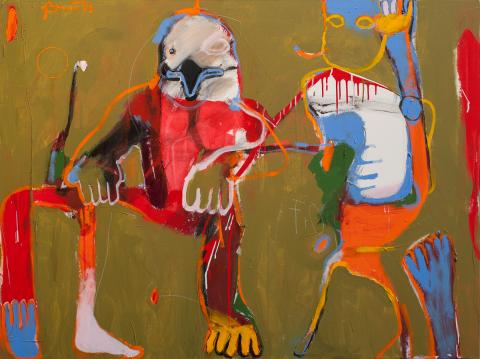
Organized by the JSMA, the exhibition represents 40 years of work and will travel to museums across the country.
EUGENE, Ore. -- (February 9, 2015) – More than 120 paintings, drawings, sculptures, and prints will be on view in “Rick Bartow: Things You Know But Cannot Explain,” a major retrospective exhibition organized by the Jordan Schnitzer Museum of Art at the University of Oregon. On view from April 18 through August 9, 2015, the exhibition opens with a ceremony on April 17, at 5:30 p.m. in front of the museum, followed by a reception from 6 to 8 p.m. Both events are open to the public.
“Things You Know But Cannot Explain” is curated by Jill Hartz, JSMA Executive Director, and Danielle Knapp, JSMA McCosh Associate Curator. Drawn from public and private collections as well as the artist’s studio, the exhibition and accompanying catalog explore themes central to the artist’s work and life: “Gesture,” “Self,” “Dialogue,” “Tradition,” and “Transformation,” as well as “New Work,” featuring exciting examples of Bartow’s production since his stroke in August 2013 that evidence a new freedom of scale and expression.
“Rick Bartow’s work is all about relationships, how the worlds of nature, humans, and spirit connect, influence, and balance one another,” says Hartz. “This nearly forty year retrospective aims to reveal the layers of Bartow’s world view and his astonishing command of materials. It has something to say to everyone.”
“Bartow is truly a master at his craft. He expertly transitions between media and techniques, and has a tremendous command of color,” says Knapp. “His knowledge of artistic, literary, and musical traditions from all over the world is balanced with the autobiographical elements he incorporates into his artwork.”
Bartow, one of the nation’s most prominent contemporary Native American artists, was born in Newport, Oregon, in 1946. He is a member of the Wiyot tribe of Northern California and has close ties with the Siletz community. He graduated in 1969 from Western Oregon University with a degree in secondary arts education and served in the Vietnam War (1969-71). His work is permanently held in more than 60 public institutions in the U.S., including Yale University Art Gallery, CT; Brooklyn Museum, NY; and Peabody Essex Museum, MA. He has had 35 solo museum exhibitions and his art has been referenced in over 250 books, catalogs, and articles.
In 2012, commissioned by The Smithsonian's National Museum of the American Indian, Bartow created “We Were Always Here,” a monumental pair of sculptures, over 20 feet high, which was installed on the National Mall in Washington, D.C.. Froelick Gallery, Portland, OR, has represented Bartow for 20 years.
Personal experiences, literature and art from around the globe inform Bartow's art. Throughout his career, he has consistently explored self-portraiture and animal imagery, often blurring the lines between the two; many describe his work as transformational and visual storytelling. Accustomed to narrative, Bartow is a life-long musician having written lyrics and music found on several CD collections. He sings lead and plays lead guitar with “The Backseat Drivers” every week in Newport.
Accompanying the exhibition is a fully illustrated catalog with essays by Hartz and Knapp, as well as Lawrence Fong, former JSMA Curator of American and Regional Art. The catalog is made possible with support from The Ford Family Foundation, Arlene Schnitzer, and Philip and Sandra Piele.
Support for the exhibition is provided by the Ford Family Fund of the Oregon Community Foundation, the Harold and Arlene Schnitzer CARE Foundation, the Coeta and Donald Barker Changing Exhibitions Endowment, a grant from the Oregon Arts Commission and the National Endowment for the Arts, a federal agency, and JSMA members.
Following its opening presentation at the JSMA, the exhibition will travel to The Autry National Center, Los Angeles, California, (Dates TBD); IAIA Museum of Contemporary Native Arts, Santa Fe, New Mexico from August 14 to December 31, 2016; The Heard Museum, Phoenix, Arizona, from April 8 to July 9, 2017; and Washington State University Museum of Art, Pullman, WA, September 29 to December 16, 2017. Additional venues are being scheduled.
About the Jordan Schnitzer Museum of Art
The University of Oregon's Jordan Schnitzer Museum of Art is a premier Pacific Northwest museum for exhibitions and collections of historic and contemporary art based in a major university setting. The mission of the museum is to enhance the University of Oregon’s academic mission and to further the appreciation and enjoyment of the visual arts for the general public. The JSMA features significant collections galleries devoted to art from China, Japan, Korea, the Americas and Europe as well as changing special exhibition galleries. The JSMA is one of six museums in Oregon accredited by the American Alliance of Museums.
The Jordan Schnitzer Museum of Art is located on the University of Oregon campus at 1430 Johnson Lane. Museum hours are 11 a.m. to 8 p.m. Wednesdays, and 11 a.m. to 5 p.m. Tuesdays and Thursdays through Sundays. Admission is $5 for adults and $3 for senior citizens. Free admission is given to ages 18 and under, JSMA members, college students with ID, and University of Oregon faculty, staff and students. For information, contact the JSMA, 541-346-3027.
About the University of Oregon
The University of Oregon is among the 108 institutions chosen from 4,633 U.S. universities for top-tier designation of "Very High Research Activity" in the 2010 Carnegie Classification of Institutions of Higher Education. The UO also is one of two Pacific Northwest members of the Association of American Universities.
Contact:
JSMA: Debbie Williamson Smith, 541-346-0942, debbiews@uoregon.edu
Links: Jordan Schnitzer Museum of Art, http://jsma.uoregon.edu/Bartow





